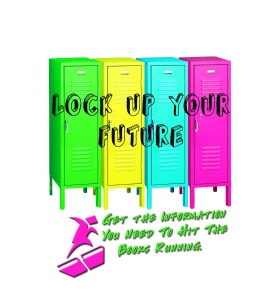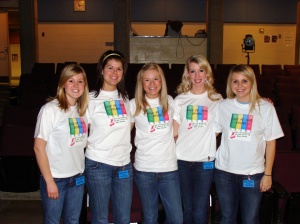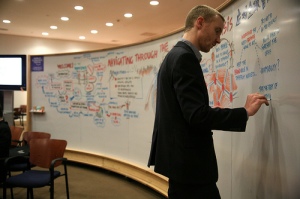 Last week, Skittles learned an important message: if you don’t know about social media/networking, don’t use it to promote your product. Skittles decided to jump on the social media bandwagon by making its homepage background the Skittle’s Facebook page, Twitter feed featuring tweets about Skittles, and the Skittles Wikipedia entry.Skittles was hoping that their audience would start talking about them on these social media sites, which they did, but didn’t expect it to backlash against them. Many of the Skittles tweets contained racial slurs, profanities, and harsh words about Skittles.
Last week, Skittles learned an important message: if you don’t know about social media/networking, don’t use it to promote your product. Skittles decided to jump on the social media bandwagon by making its homepage background the Skittle’s Facebook page, Twitter feed featuring tweets about Skittles, and the Skittles Wikipedia entry.Skittles was hoping that their audience would start talking about them on these social media sites, which they did, but didn’t expect it to backlash against them. Many of the Skittles tweets contained racial slurs, profanities, and harsh words about Skittles.
I think it’s great that Skittles wants to use social media to promote its product–many companies use social media sites to promote their organization or product. However, I think the way Skittles used social media was a bad move on their part. Sure, people are now talking about their company, but the focus got a away from the product and on to their social media mishaps.
Shiv Singh, author of the post “Did Skittles Scuttle its brand? Time will Tell,” makes some great points about how Skittles could have used social media to their advantage, without turning it into a “what not to do in social media” case study. He basically said that Skittles didn’t target its audience: it basically assumed that its customers are on Twitter, when really, only some of its audience is on Twitter. This is the same for Facebook. He also says that Skittles was more interested in having people look at its page and observing the fact that they are trying to incorporate social media to their marketing strategy, that they were actually forgetting to fuel conversations and participation by its audience.
Although Skittles has changed its page and is now incorporating social media to its advantage, it should have tested the waters of the social media pool before taking the plunge into the deep end.

 Being in college, I am used to giving many different kinds of presentations–English, Business Administration, PR, Oregon News Pitches, French, etc. And until last week, I thought I gave great presentations. But, last week my professor,
Being in college, I am used to giving many different kinds of presentations–English, Business Administration, PR, Oregon News Pitches, French, etc. And until last week, I thought I gave great presentations. But, last week my professor,  A classmate of mine,
A classmate of mine, 
 I had my doubts about this event at first. I didn’t know how a few volunteers would be able to tame and entertain 300 middle school students, but I was completely wrong. Not only were these students well behaved, but they were actually excited about college. I remember being in eighth grade and wondering if I would even make it to high school; at that point, I wasn’t even interested in going to college. I think if I would have had a workshop like this when I was in middle school, I would have worked much harder in high school to obtain scholarships for college. This kind of program should be available to all eighth grade students, and possibly even required by all schools.
I had my doubts about this event at first. I didn’t know how a few volunteers would be able to tame and entertain 300 middle school students, but I was completely wrong. Not only were these students well behaved, but they were actually excited about college. I remember being in eighth grade and wondering if I would even make it to high school; at that point, I wasn’t even interested in going to college. I think if I would have had a workshop like this when I was in middle school, I would have worked much harder in high school to obtain scholarships for college. This kind of program should be available to all eighth grade students, and possibly even required by all schools.
 According to the
According to the  I am learning in my PR classes how important social media is–especially in the PR world. I’m learning about blogging,
I am learning in my PR classes how important social media is–especially in the PR world. I’m learning about blogging, 


 I am currently completing my senior year of college (yay!) and I am planning on applying for jobs and starting the interview process next term. During my time in college, I’ve held several jobs–most of them at local sandwich shops–so I’m already a step ahead of those who have never had an interview for a job before. Even though all of my interviews have been casual, I still freak out when they ask me the hardest question (I think) to answer, “What is your greatest weakness?”
I am currently completing my senior year of college (yay!) and I am planning on applying for jobs and starting the interview process next term. During my time in college, I’ve held several jobs–most of them at local sandwich shops–so I’m already a step ahead of those who have never had an interview for a job before. Even though all of my interviews have been casual, I still freak out when they ask me the hardest question (I think) to answer, “What is your greatest weakness?” –but I tend to put stuff off until the last possible minute before it needs to be done. I do this with everything in life: homework, laundry, writing thank you letters, etc., but it’s gotten to the point that I’ve made it a point in my life to try and limit this behavior.
–but I tend to put stuff off until the last possible minute before it needs to be done. I do this with everything in life: homework, laundry, writing thank you letters, etc., but it’s gotten to the point that I’ve made it a point in my life to try and limit this behavior.